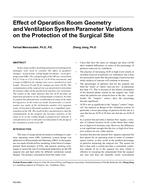Simulation, laboratory, and field studies in a hot, humid climate were conducted to investigate the thermal and hygrothermalperformance of ducts buried in blown-in insulation in vented attics. Ducts that leak in vented attic can carry a large energy penalty.The U.S. Department of Energy’s Zero Energy Ready Home National Program Requirements ask for ducts to be located within thehomes’ thermal and air barrier boundary. An alternative to placing the ducts in conditioned space is to bury the ducts inside theinsulation. The surface temperature of the duct insulation that includes a vapor barrier may fall below the dew point of the attic airand cause condensation. This paper includes details of a study performed to evaluate the condensation potential with different ductR-values, duct size, ceiling R-values, and air leakage characteristics. Both flexible ducts and square ducts with duct board were investigated.The measured relative humidity around the ducts suggests that current encapsulation recommendations may be overlyconservative and that ducts buried in the insulation with proper duct R-value for each climate do not experience condensation thatcould cause moisture damage. The research for this paper focused on Climate Zones 5A (Cleveland, OH) and 3A (Charleston, SC).
Citation: Thermal Performance of Exterior Envelopes of Whole Buildings XIII, Conference Papers
Product Details
- Published:
- 2016
- Number of Pages:
- 9
- Units of Measure:
- Dual
- File Size:
- 1 file , 7.8 MB
- Product Code(s):
- D-BldgConf16-41


